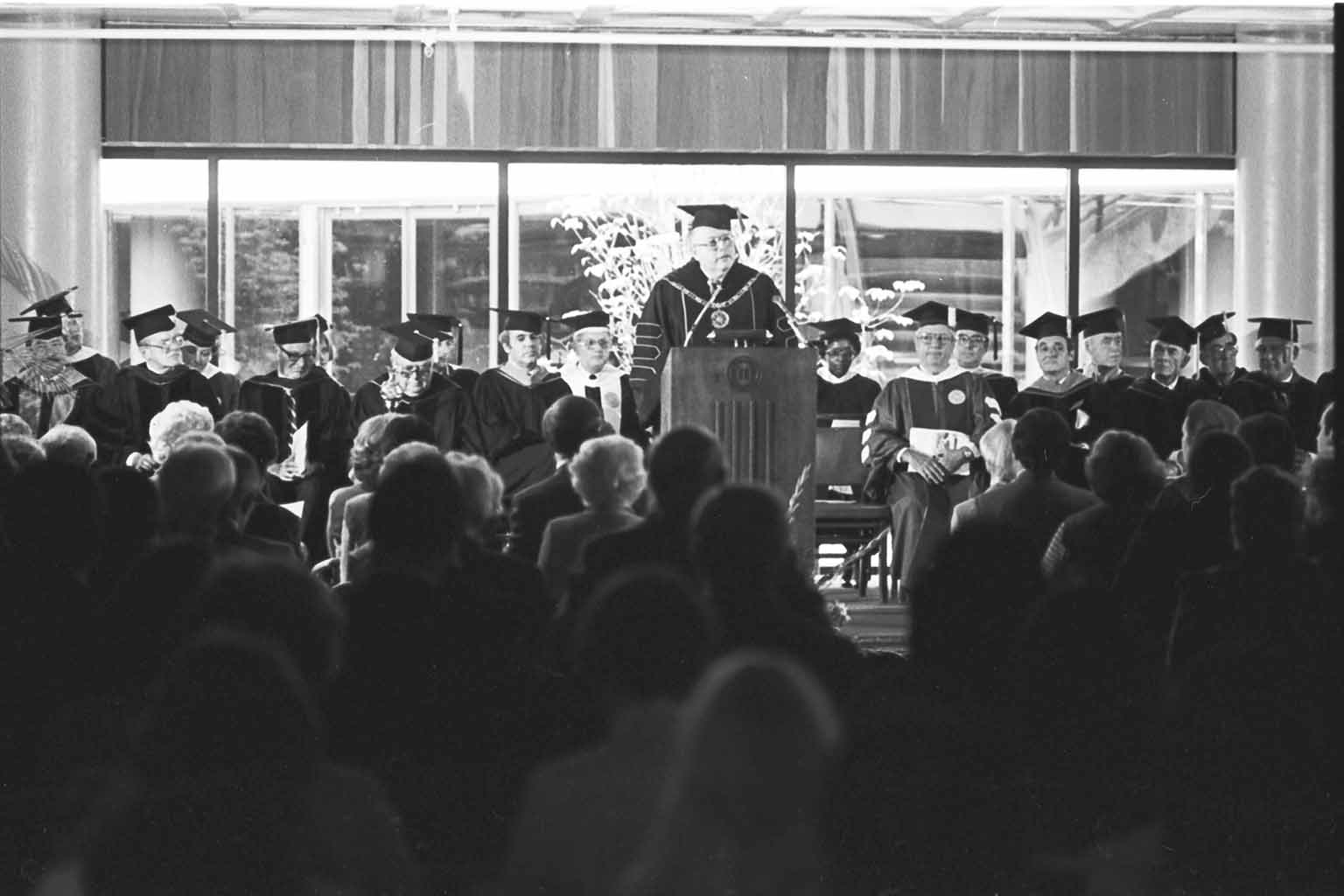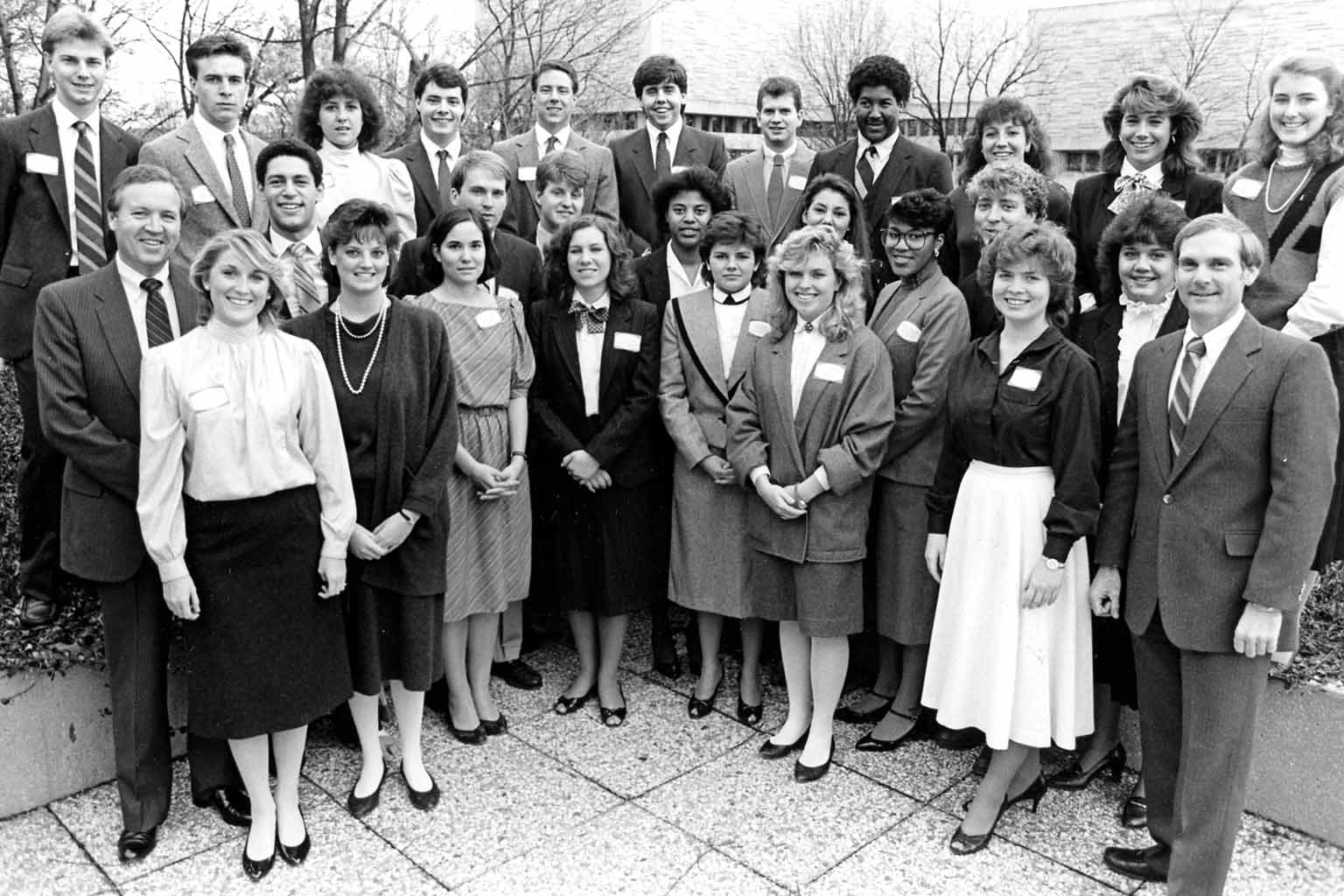The announcement was the culmination of years of work to reorganize activities on campus to better serve the state and prepare students for a future that was changing. The idea originated in the mid-1960s when a “Center for the Study of the Human Environment” was proposed during a Science Advisory Committee meeting. The proposal focused on collaborative education to solve problems created by human activity.
The idea remained as the IU administration saw a flurry of leadership changes, but the arrival of John Ryan as IU president in fall 1970 pushed the previously shelved proposal to the forefront.
“There was considerable concern among faculty, staff, and students that we needed to make the university relevant to solving the problems of the real world,” Charles “Chuck” Bonser said during the 40th anniversary celebration of the school.
Bonser, who was associate dean of the IU School of Business, was tapped to serve as founding dean for SPEA. Charles Wise was appointed the first faculty member of the school, and after finding an administrative home in the Poplars Building, the school welcomed its first cohort of students in fall 1972. Classes were held in Ballantine Hall, and SPEA initially offered bachelor’s and master’s degrees in public affairs, an associate of science degree, and a host of nondegree programs.
SPEA also was established on other IU campuses, including a location at IUPUI, and quickly attracted real-world experts from public and environmental roles to its faculty.
“We have to get across to students preparing for careers in public affairs that they must learn to keep up with what’s current and learn to separate the important material from that which is not so important,” said Richard Howe, one of the first faculty members hired by the school.
A Master of Science in Environmental Science was established in 1975, and a Ph.D. in Public Policy program was put in place in 1978. Ground was broken in September 1978 for a building to house the IU School of Business and SPEA on the IUPUI campus.
Enrollment began to take off. In 1975, 607 students were enrolled in undergraduate courses, and by 1979, that number more than doubled to 1,333.
Meanwhile, in Bloomington, a new, four-story SPEA building was planned for the center of campus featuring a courtyard connected to the Business School, a shared underground library, and hanging gardens on the terrace of each level.
Despite being a relatively young school, SPEA was getting noticed by its peers.
In 1980, the school was singled out by the National Association of Schools of Public Affairs and Administration (NASPAA) as being a model graduate program for other schools.
“Indiana University, through its School of Public and Environmental Affairs, has accepted the challenge of conceiving, designing, and managing a singular program for the differing needs of various parts of the state of Indiana,” a NASPAA report read. “It has done so in a fashion which maintains quality, assures transferability of student work, and standardizes the meaning of the degree while serving well the various clienteles.”
A NASPAA poll of its 250 member schools during this same time saw SPEA rank first in published research and fourth in overall peer prestige.
SPEA celebrated its 10th anniversary with the opening of its new home and a yearlong celebration. The school had grown from 25 students in the first graduating class to 351 in 1982, and the number of faculty more than doubled from 41 to 90 in that same span.
In 1987, founding dean Bonser stepped down and A. James Barnes, former deputy administrator for the United States Environmental Protection Agency, was selected as the new dean. Under Barnes’ leadership, SPEA was selected as the Midwestern Regional Center for the U.S. Department of Energy’s National Institute for Global Environmental Change to address the growing discussion of climate change.
In 1994, the School of Public and Environmental Affairs at both IU Bloomington and IUPUI played critical roles in the Parliamentary Development Project for Ukraine, a partnership with the country that has grown over time. The Center on Urban Policy and the Environment also was established at IUPUI.
Enrollment continued to expand, and when SPEA celebrated its 25th anniversary in 1997, it included more than 100 full-time faculty, 600 graduate students, and 1,600 undergraduate students, making it the largest school of its kind.
The school also reached No. 3 in U.S. News & World Report’s rankings of “America’s Top Graduate Schools” in 1998, the highest-ranked graduate program at IU that year.
“We are delighted, of course, that the quality of the program we have put together is recognized,” said Barry Rubin, the associate dean of graduate programs in Bloomington. “In our 25-year existence, we have made strides in developing a program that is nationally ranked. Our faculty have been very productive as researchers and scholars.”
After leading the school for 12 years, Barnes stepped down as dean in 2000. Barnes’ ability to recruit fresh faculty talent had encouraged interdisciplinary collaboration and expanded SPEA’s footprint at IU and on national and global scales.
“I feel very good about the school’s position,” Barnes said. “We are in company with Harvard and Princeton, so we have good people and good programs. I think it makes sense to turn it over to someone else at this point.”
That someone else was Astrid Merget, a former senior advisor to the secretary of the U.S. Department of Health and Human Services during the Jimmy Carter and Bill Clinton administrations.
“I know both Barnes and Bonser,” Merget said. “My vision builds on their visions. Each advanced the school significantly to a position of national recognition. My goal is to capitalize on their vision and project the school into the 21st century.”
She did just that, and in 2004, SPEA continued to be ranked No. 3 in the country by the U.S. News & World Report. Several programs both at IU Bloomington and IUPUI were highly ranked, including
No. 1 rankings for the nonprofit management program and environmental policy and management program.
Merget grew the school’s program portfolio, including the arts administration program, and helped solidify SPEA’s reputation with the Journal of Policy Analysis and Management editorship. The school’s overseas education program grew via a partnership with the University of Oxford.
Merget stepped down as dean in 2007, and in 2008, John D. Graham, a former top official with the White House Office of Management and Budget, was named the school’s fourth dean. He quickly established a Dean’s Council that included respected leaders from business, government, and the nonprofit sector. He also expanded SPEA’s overseas education programs to include Germany, Spain, China, and other locations.
The whole world noticed SPEA in 2009 when Elinor Ostrom, a SPEA professor and Arthur F. Bentley Professor of Political Science in the IU College of Arts and Sciences, became the first woman honored with the Nobel Prize in Economic Sciences.
By the time SPEA celebrated its 40th anniversary, its reputation was known the world over.
“It’s widely admired nationally,” said then-IU President Michael A. McRobbie. “It is one of the academic jewels in the university’s crown.”
SPEA continued to rise in the U.S. News & World Report rankings, sharing the No. 2 overall spot with Harvard’s Kennedy School in 2011, and the school ranked No. 1 in environmental policy and management and in nonprofit management. Meanwhile, the Civic Leaders Living Learning Center was established at Briscoe Quadrangle in 2012.
SPEA made headlines in March 2014 when Paul O’Neill, who earned his MPA from IU in 1966 and was former Secretary of the Treasury under President George W. Bush, gave a $3 million gift, the largest private donation in the school’s history to that point, to partially fund a new graduate center. The three-story structure would change the face of SPEA and revision the courtyard between the SPEA building and the Kelley School of Business. David and Cecile Wang donated $1 million to name the second-floor study and meeting space.
SPEA reached a major milestone in 2016 when U.S. News & World Report’s ranking of the best graduate schools listed SPEA in the top spot. The MPA ranked No. 1, and specializations in environmental policy and management, nonprofit management, and public finance and budgeting ranked No. 1 as well.
“This is a momentous day for Indiana University and for SPEA,” Graham said. “To be ranked as the top program in the nation, ahead of legendary programs such as Harvard and Princeton, is a crowning achievement for our faculty and staff.”
In honor of a $30 million gift, the school was renamed the Paul H. O’Neill School of Public and Environmental Affairs in 2019. The gift provides support for the Paul H. O’Neill Center on Leadership in Public Service; a dean’s initiatives fund; three faculty chair positions; five professorships; a fellowship program for master’s, doctoral, and postdoctoral students; and a scholarship program, which will continue in perpetuity.
“I am honored to now have the opportunity to give back to this exemplary institution, which means so much to me,” O’Neill said. “My hope is that the school remains a place of excellence where future leaders can combine passion with action and develop the confidence they need to engage with society’s greatest challenges and opportunities.”
Graham stepped down as dean in 2019, and was followed by Siân Mooney, Arizona State University associate dean for interdisciplinary programs and initiatives.
“The O’Neill School’s great strength is its unique ability to support science in service to society,” Mooney said. “The O’Neill School’s alumni have a long record of leadership and accomplishments, creating and implementing public policies that make a positive difference for Indiana and beyond.”
The O’Neill School continued to make headlines, including O’Neill School Distinguished Professor David Audretsch being named a Clarivate Citation Laureate. The school also established a chapter of the NextGen Leadership Program to develop leadership skills and public service interest in students.
During its 50 years, the O’Neill School has become one of the most respected institutions in the nation and the world. Its reputation has been built on stable leadership, visionary faculty, and driven students who have taken the lessons learned in the classroom and applied them to solve complex problems to make a difference for the greater good.





